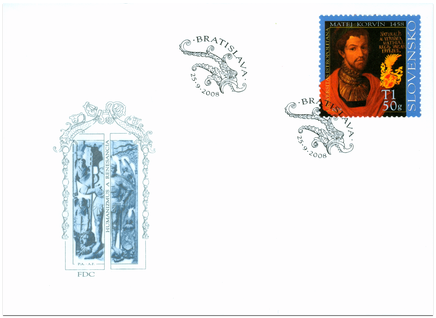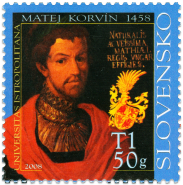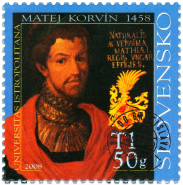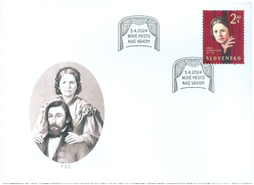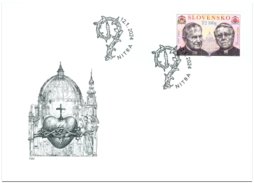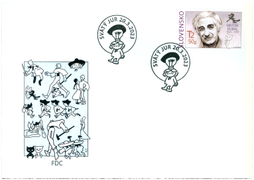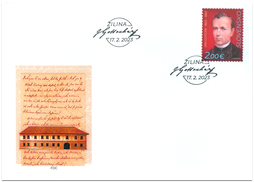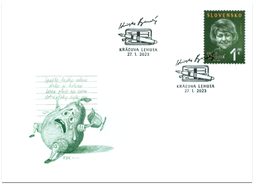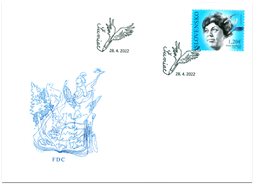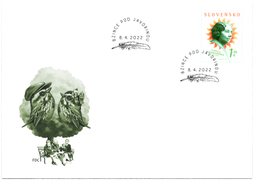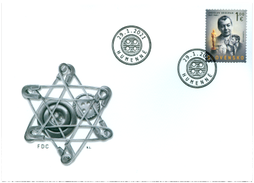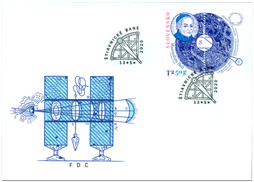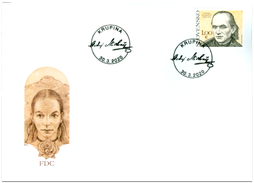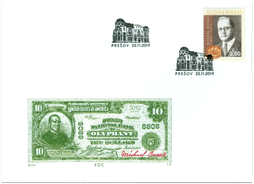FDC 428 Date of issue
25.09.2008 Sell price
1.20 €
T1 50 g responds to the rate of postage of the 1st class up to 50 g - domestic servis. © Slovak Post, 2008 In 2008, the Slovak Post commemorates the 550th anniversary of the coronation of Matthias Corvinus (23. 2. 1443 – 6. 4. 1490) the King of Hungary from 1458. The stamp issue pays tribute to King Matthias, who ordered the founding of the Universitas Istropolitana in 1465, the first university on Slovak territory. Today, this university building in late-Gothic style is the seat of the Academy of Performing Arts in Bratislava. Matthias was the son of John Hunyadi, the regent of Hungary, and his later epithet ‘Corvinus’ was created by Renaissance scholar and Matthias’s biographer Antonio Bonfini. He worked at the King’s Court and created his epithet according the crow in his heraldry what derived from the name of ancient Roman gens Corvini. Mathias was educated in a humanistic Renaissance spirit, which influenced Hungary at that time. He established an extensive library Bibliotheca Corviniana in his castle at Buda, with translations of significant works by various antiquity writers. Many Renaissance scholars worked at his Court, including Marsilio Ficino and the renowned Italian artists Filippo Lippi and Verrocchio. The stamp depicts one of the rare preserved faithful replicas of Matthias portrait painted ‘naturali ac verissima effigies’ by an unknown 18th century Austrian artist. The painting is located in the collections of City Gallery of Bratislava. Few Renaissance artefacts from Matthias’s reign in the Slovak territory were preserved, as they were regarded merely as fashion fads of the Court – something which today’s scholars term the ‘shadow Renaissance’. This pattern, however, can be found in the tombstones of two of Matthias’s contemporaries, Imrich and Stephen Zápolya portrayed in the FDC. They were members of one of the most significant gens in the territory of medieval Hungary. Stephen Zápolya, the Duke of Hungary, worked in the service of the King, and his son John in 1526 became the King of Hungary. Today, the tombstones can be found in the Church of St. Martin at Spišská Kapitula. The FDC cancellation also depicts Renaissance ornaments taken from burgher-house architecture in Levoča to evidence the so-called ‘authentic Renaissance’, reflecting the prosperity of the burgher class in the region of Spiš. Martin Vančo
Show lessSimilar products
FDC 814 Date of issue
05.04.2024
FDC 810 Date of issue
12.01.2024
FDC 791 Date of issue
20.03.2023
FDC 786 Date of issue
17.02.2023
FDC 785 Date of issue
27.01.2023
FDC 764 Date of issue
28.04.2022
FDC 763 Date of issue
08.04.2022
FDC 754 Date of issue
26.11.2021
FDC 733 Date of issue
29.01.2021
FDC 712 Date of issue
13.05.2020
FDC 710 Date of issue
30.03.2020
FDC 703 Date of issue
22.11.2019
© 2024 POFIS - Postal philatelic service. All rights reserved

